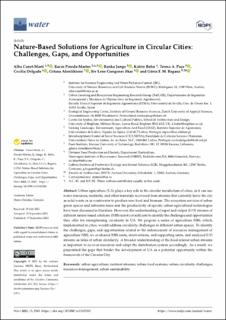Nature-Based Solutions for Agriculture in Circular Cities: Challenges, Gaps, and Opportunities
| dc.contributor.author | Canet-Martí, Alba | |
| dc.contributor.author | Pineda-Martos, Rocío | |
| dc.contributor.author | Junge, Ranka | |
| dc.contributor.author | Bohn, Katrin | |
| dc.contributor.author | Paço, Teresa A. | |
| dc.contributor.author | Delgado, Cecilia | |
| dc.contributor.author | Alencikiene, Gitana | |
| dc.contributor.author | Skar, Siv | |
| dc.contributor.author | Baganz, Gösta F. M. | |
| dc.date.accessioned | 2022-02-15T08:28:41Z | |
| dc.date.available | 2022-02-15T08:28:41Z | |
| dc.date.created | 2022-01-28T19:53:58Z | |
| dc.date.issued | 2021-09-17 | |
| dc.identifier.citation | Water. 2021, 13 (18), . | en_US |
| dc.identifier.issn | 2073-4441 | |
| dc.identifier.uri | https://hdl.handle.net/11250/2978953 | |
| dc.description.abstract | Urban agriculture (UA) plays a key role in the circular metabolism of cities, as it can use water resources, nutrients, and other materials recovered from streams that currently leave the city as solid waste or as wastewater to produce new food and biomass. The ecosystem services of urban green spaces and infrastructures and the productivity of specific urban agricultural technologies have been discussed in literature. However, the understanding of input and output (I/O) streams of different nature-based solutions (NBS) is not yet sufficient to identify the challenges and opportunities they offer for strengthening circularity in UA. We propose a series of agriculture NBS, which, implemented in cities, would address circularity challenges in different urban spaces. To identify the challenges, gaps, and opportunities related to the enhancement of resources management of agriculture NBS, we evaluated NBS units, interventions, and supporting units, and analyzed I/O streams as links of urban circularity. A broader understanding of the food-related urban streams is important to recover resources and adapt the distribution system accordingly. As a result, we pinpointed the gaps that hinder the development of UA as a potential opportunity within the framework of the Circular City. | en_US |
| dc.language.iso | eng | en_US |
| dc.publisher | MDPI, Basel, Switzerland | en_US |
| dc.rights | Navngivelse 4.0 Internasjonal | * |
| dc.rights.uri | http://creativecommons.org/licenses/by/4.0/deed.no | * |
| dc.title | Nature-Based Solutions for Agriculture in Circular Cities: Challenges, Gaps, and Opportunities | en_US |
| dc.type | Peer reviewed | en_US |
| dc.type | Journal article | en_US |
| dc.description.version | publishedVersion | en_US |
| dc.rights.holder | © 2021 by the authors | en_US |
| dc.source.pagenumber | 22 | en_US |
| dc.source.volume | 13 | en_US |
| dc.source.journal | Water | en_US |
| dc.source.issue | 18 | en_US |
| dc.identifier.doi | 10.3390/w13182565 | |
| dc.identifier.cristin | 1992930 | |
| dc.relation.project | COST (European Cooperation in Science and Technology): CA17133 Circular City | en_US |
| dc.source.articlenumber | 2565 | en_US |
| cristin.ispublished | true | |
| cristin.fulltext | original | |
| cristin.qualitycode | 1 |
Tilhørende fil(er)
Denne innførselen finnes i følgende samling(er)
-
Divisjon for matproduksjon og samfunn [999]
Publikasjoner knyttet til ansatte ved Divisjon for matproduksjon og samfunn -
Publikasjoner fra CRIStin - NIBIO [4517]
-
Vitenskapelige artikler [1416]

